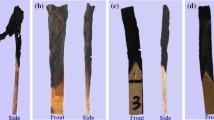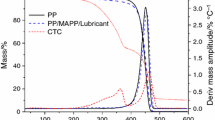Abstract
The present study deals with the effects of wood flour on thermal and burning properties of wood flour-poly(vinyl chloride) composites (WF-PVC) using thermogravimetric (TG), cone calorimetry (CONE), and pyrolysis–gas chromatography/mass spectrometry (Py–GC/MS). TG tests show that an interaction occurred between wood flour and PVC during the thermal degradation of WF-PVC. Wood flour decreased the temperature of onset of decomposition of PVC. However, the char formation could be increased by adding wood flour to PVC. CONE test indicates that wood flour had positive effects on heat release and smoke emission of PVC. Comparing with PVC, WF-PVC reduced average heat release rate and the peak HRR by about 14 and 28%, respectively; smoke production rate was also decreased. The degradation mechanism was studied by Py–GC/MS. The results show that the volatile pyrolysis products of WF-PVC are very different from PVC. The yields of HCl and aromatic compounds decreased dramatically, and the aliphatic compounds increased by the incorporation of WF.







Similar content being viewed by others
References
Morton J, editor. Current and emerging applications for natural & wood fiber composites. In: Proceedings of the 7th international conference on wood fiber-plastic composites. Madison: Forest Products Society; 2003. p. 19–20.
Oksman K, Lindberg H, Holmgren A. The nature and location of SEBS-MA compatibilizer in polyethylene-wood flour composites. J Appl Polym Sci. 1998;69:201–9.
Xiong C, Qi RR, Wang YL. Wood-thermoplastic composites from wood flour and high-density polyethylene. J Appl Polym Sci. 2009;114:1160–8.
Raj RG, Kokta BV, Maldas D, Daneault C. Use of wood fibers in thermoplastics: VI. The effect of coupling agents in polyethylene wood fiber composites. J Appl Polym Sci. 1989;37:1089–103.
Raj RG, Kokta BV, Daneault C. Polypropylene-wood fiber composites—effect of fiber treatment on mechanical-properties. Int J Polym Mater. 1989;12:239–50.
Klason C, Kubat J, Gatenholm P. Wood fiber reinforced composites. ACS Symp Ser. 1992;489:82–98.
Kazayawoko M, Balatinecz JJ, Matuana LM. Surface modification and adhesion mechanisms in woodfiber-polypropylene composites. J Mater Sci. 1999;34:6189–99.
Maldas D, Kokta BV, Raj RG, Daneault C. Improvement of the mechanical-properties of sawdust wood fiber polystyrene composites by chemical treatment. Polymer. 1988;29:1255–65.
Nair KCM, Thomas S, Groeninckx G. Thermal and dynamic mechanical analysis of polystyrene composites reinforced with short sisal fibres. Compos Sci Technol. 2001;61:2519–29.
Matuana LM, Woodhams RT, Balatinecz JJ, Park CB. Influence of interfacial interactions on the properties of PVC cellulosic fiber composites. Polym Compos. 1998;19:446–55.
Jiang HH, Kamdem DP. Development of poly(vinyl chloride)/wood composites. A literature review. J Vinyl Addit Technol. 2004;10:59–69.
Djidjelli H, Martinez-Vega JJ, Farenc J, Benachour D. Effect of wood flour content on the thermal, mechanical and dielectric properties of poly(vinyl chloride). Macromol Mater Eng. 2002;287:611–8.
Jiang HH, Kamdem DP. Thermal and dynamic mechanical behavior of poly(vinyl chloride)/wood flour composites. J Appl Polym Sci. 2008;107:951–7.
Lu JZ, Wu QL, Negulescu II. Surface and interfacial characterization of wood-PVC composites: thermal and dynamic mechanical properties. Wood Fiber Sci. 2004;36:500–10.
Sombatsompop N, Chaochanchaikul K, Phromchirasuk C, Thongsang S. Effect of wood sawdust content on rheological and structural changes, and thermo-mechanical properties of PVC/sawdust composites. Polym Int. 2003;52:1847–55.
McGhee B, Norton F, Snape C, Hall P. The copyrolysis of poly (vinylchloride) with cellulose derived materials as a model for municipal waste derived chars. Fuel. 1995;74:28–31.
Matsuzawa Y, Ayabe M, Nishino J. Acceleration of cellulose co-pyrolysis with polymer. Polym Degrad Stab. 2001;71:435–44.
Matsuzawa Y, Ayabe M, Nishino J, Kubota N, Motegi M. Evaluation of char fuel ratio in municipal pyrolysis waste. Fuel. 2004;83:1675–87.
Kuramochi H, Nakajima D, Goto S, Sugita K, Wu W, Kawamoto K. HCl emission during co-pyrolysis of demolition wood with a small amount of PVC film and the effect of wood constituents on HCl emission reduction. Fuel. 2008;87:3155–7.
Saeed L, Tohka A, Haapala M, Zevenhoven R. Pyrolysis and combustion of PVC, PVC-wood and PVC-coal mixtures in a two-stage fluidized bed process. Fuel Process Technol. 2004;85:1565–83.
Rocha N, Kazlauciunas A, Gil MH, Goncalves PM, Guthrie JT. Poly(vinyl chloride)-wood flour press mould composites: the influence of raw materials on performance properties. Compos Part A. 2009;40:653–61.
Zhao YS, Wang KJ, Zhu FH, Xue P, Jia MY. Properties of poly(vinyl chloride)/wood flour/montmorillonite composites: effects of coupling agents and layered silicate. Polym Degrad Stab. 2006;91:2874–83.
Levchik SV, Weil ED. Overview of the recent literature on flame retardancy and smoke suppression in PVC. Polym Adv Technol. 2005;16:707–16.
d’Almeida ALFS, Barreto DW, Calado V, d’Almeida JRM. Thermal analysis of less common lignocellulose fibers. J Therm Anal Calorim. 2008;91:405–8.
Biagiotti J, Puglia D, Kenny JM. A review on natural fibre-based composites-part I: structure, processing and properties of vegetable fibres. J Nat Fibers. 2004;1:37–68.
Das S, Saha AK, Choudhury PK, Basak RK, Mitra BC, Todd T, et al. Effect of steam pretreatment of jute fiber on dimensional stability of jute composite. J Appl Polym Sci. 2000;76:1652–61.
Demirbas A, Arin G. An overview of biomass pyrolysis. Energy Source. 2002;24:471–82.
Yao F, Wu QL, Lei Y, Guo WH, Xu YJ. Thermal decomposition kinetics of natural fibers: activation energy with dynamic thermogravimetric analysis. Polym Degrad Stab. 2008;93:90–8.
Gao M, Li SY, Sun CY. Thermal degradation of wood in air and nitrogen treated with basic nitrogen compounds and phosphoric acid. Combust Sci Technol. 2004;176:2057–70.
Chapple S, Anandjiwala R. Flammability of natural fiber-reinforced composites and strategies for fire retardancy: a review. J Thermoplast Compos. 2010;23:871–93.
McNeill I, Memetea L, Cole W. A study of the products of PVC thermal degradation. Polym Degrad Stab. 1995;49:181–91.
Leisztner L, Gal S, Szanto J, Kovacs L. Influence of the morphology of samples in the Pyrolysis of PVC. J Therm Anal. 1978;13:141–7.
Karayildirim T, Yanik J, Yuksel M, Saglam M, Vasile C, Bockhorn H. The effect of some fillers on PVC degradation. J Anal Appl Pyrol. 2006;75:112–9.
Wang QW. Principle of fire-retardant technology for wood. Harbin: Northeast Forestry University Press; 2000. p. 126–9.
Scudamore M, Briggs P, Prager F. Cone calorimetry—a review of tests carried out on plastics for the association of plastic manufacturers in Europe. Fire Mater. 1991;15:65–84.
Hirschler MM. Heat release in fires. London: Elsevier Applied Sciences; 1992.
Spearpoint MJ, Quintiere JG. Predicting the burning of wood using an integral model. Combust Flame. 2000;123:308–25.
Li B, Wang J. Effect of curprous oxide in combination with molybdenum trioxide on smoke suppression in rigid poly (vinyl chloride). J Vinyl Addit Technol. 2001;7:37–42.
Starnes W. Cone calorimetric study of copper-promoted smoke suppression and fire retardance of poly (vinyl chloride). Polym Degrad Stab. 2003;82:15–24.
Li B. A study of the thermal decomposition and smoke suppression of poly(vinyl chloride) treated with metal oxides using a cone calorimeter at a high incident heat flux. Polym Degrad Stab. 2002;78:349–56.
Lattimer RP, Pausch JB, Meuzelaar HLC. Pyrolysis studies of chlorinated poly (vinyl chloride). Macromolecules. 1983;16:1896–900.
Stromberg RR, Straus S, Achhammer BG. Thermal decomposition of poly (vinyl chloride). J Polym Sci. 1959;35:355–68.
Fabbri D, Tartari D, Trombini C. Analysis of poly(vinyl chloride) and other polymers in sediments and suspended matter of a coastal lagoon by pyrolysis-gas chromatography-mass spectrometry. Anal Chim Acta. 2000;413:3–11.
Montaudo G, Puglisi C. Evolution of aromatics in the thermal degradation of poly (vinyl chloride): a mechanistic study. Polym Degrad Stab. 1991;33:229–62.
Acknowledgements
The authors are grateful for the support from the Chinese Natural Science Foundation for projects 30972313 and 31010103905 and the Breeding Plan of Excellent Doctoral Dissertation of Northeast Forestry University (GRAP09) in China. Y. Fang also thanks the China Scholarship Council (CSC) for financial support to study at the University of Toronto.
Author information
Authors and Affiliations
Corresponding author
Rights and permissions
About this article
Cite this article
Fang, Y., Wang, Q., Bai, X. et al. Thermal and burning properties of wood flour-poly(vinyl chloride) composite. J Therm Anal Calorim 109, 1577–1585 (2012). https://doi.org/10.1007/s10973-011-2071-y
Received:
Accepted:
Published:
Issue Date:
DOI: https://doi.org/10.1007/s10973-011-2071-y




